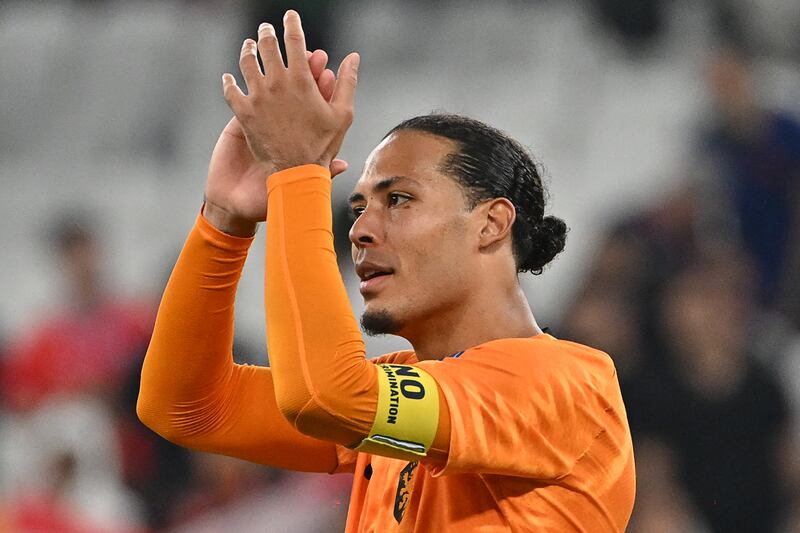The defining moment of the Netherlands-Senegal game brought back memories of Robbie Brady’s goal against Italy. Frenkie de Jong starred as Wes Hoolahan, curling in an irresistible diagonal cross, while Brady was played by Cody Gakpo, who reached the ball just before the onrushing goalkeeper to head it into an empty net.
The scenes in the stands, though, were nothing like the rapturous, tearful masses Brady ran towards in Lille. On paper this was one of the most attractive of the first round of matches, and on paper it had an attendance to match. History will record that the official attendance was announced at 41,721. (The figure was impressive given the 40,000 capacity of the Al-Thumama stadium, though not as impressive as the 67,000 who officially crammed into the 60,000-seater Al Bayt stadium for Qatar v Ecuador).
In reality there were at least 10,000 empty seats. Given Qatar has supposedly spent €200 billion on this World Cup, they might have considered paying some (or perhaps “more”) people to show up to make it look like the big-time occasion it is still supposed to be.
Louis van Gaal said on Sunday that he feels the current Dutch squad has more quality than the one he led to third place at Brazil 2014. Certainly in 2014, the Netherlands didn’t have a defender like Virgil van Dijk (unless you count Van Dijk himself, then 23 and already impressing for Celtic, though not enough to impress van Gaal), nor a midfielder with the ability and intelligence of de Jong.
READ MORE
But they did have Arjen Robben and Robin van Persie up front, giving them the cutting edge to make their counter-attacking style dangerous. Without Memphis Depay, who was not fit enough to start, van Gaal’s starting attack was composed of two players who failed at Spurs: Steven Bergwijn and Vincent Janssen, supported by the tall PSV forward Cody Gakpo, who has been tearing up the Dutch league, but is still untested at the highest level.

As for Senegal, few countries would cope well with losing the greatest player in their history to injury the week before the World Cup. Even with Sadio Mané, this Senegal team often struggles to score. In the victorious Africa Cup of Nations campaign they won their group scoring one goal in three games – and that was a 97th minute Mané penalty. Three of their seven matches finished 0-0.
Van Gaal admires Mané as much as anybody. He talked on Sunday about why he tried to sign the forward when he was coaching Manchester United in 2015: “He can break open any game.”
That was the quality both teams were missing in a game that was balanced and competitive but also slow and ponderous. There was nobody with Mané's gift of wriggling through gaps where none seem to exist.
The area where something seemed most likely to happen was on Senegal’s left wing, where Ismaila Sarr was up against the Netherlands’ right-sided centre back, Matthijs de Ligt. In 2017, the 17-year-old de Ligt became the youngest player to represent the Netherlands since the 1930s. Clearly, few are physically capable of competing at that level at 17 – but the powerfully-built de Ligt was already a man.
And then it’s as though he just ... kept getting bigger ... to the point where “powerful” starts to shade into “bulky and cumbersome”. He has nevertheless been signed by Juventus and then Bayern for combined transfer fees in excess of €150 million. It goes to show the value of that Ajax branding: if you didn’t already know he was a prodigy you might mistake him for a rather ordinary big defender. A good player to have attacking a corner, but vulnerable when forwards run at him.
At last year’s Euros he was sent off in Holland’s second-round defeat to the Czechs for handling the ball after falling over under pressure from Patrick Schick. Here he miscontrolled the first ball that came to him, then was lucky to escape without a booking for a heavy foul on Sarr a couple of minutes later.
In the second half he did get booked for bodyslamming Sarr, then was left helplessly burned for pace by the winger. The problem was that Senegal never quite managed to turn these situations into the kind of combinations that open defences up. There were too many shots from wide angles towards the near post. The one time they did work the ball into a promising central goalscoring position, Idrissa Gueye blasted his shot straight at the 6′9″ Dutch keeper Andries Noppert.
Holland’s approach was patient, seeking to release the right wing-back Dumfries into crossing positions, but the closest they came in the first hour of the game was Van Dijk’s header just over from a corner. The forwards never threatened and Gakpo was hardly involved.
With 30 minutes to go van Gaal decided the time had come to unleash Memphis, who replaced the willing but limited Janssen, but despite this injection of speed and shooting ability the game continued to be scrappy and largely patternless.
Van Gaal’s next move broke open the game. He replaced the tiring forward Steven Bergwijn with the midfielder Davy Klaasen, and midfielder Steven Berghuis with the more defensively-minded Teun Koopmeiners. This allowed Gakpo to move up front alongside Memphis, while De Jong was playing further forward alongside Klaasen, with Koopmeiners at the back of midfield. Within five minutes, De Jong and Gakpo had combined in their new positions for the opening goal.
Klaasen soon added a second on the counter, converting the rebound after Mendy parried a Memphis shot. The result was cruel on Senegal, but they will have a chance to regroup and regain their confidence on Friday against Qatar, ahead of what looks likely to be a qualification showdown with Ecuador next Tuesday.















